Hint: Identify the nutrients present in different foods, in order to have a balanced diet.
Question.1. Which of these foods are rich in carbohydrates?
(a) gram
(b) wheat
(c) soyabean
(d) pigeon pea
Question.2. Which combination of foods would provide a balanced diet?
(a) pea, black gram, lentil, rice
(b) rice, maize, millets, sorghum
(c) rice, lentil, groundnut, vegetables and fruits
(d) soyabean, groundnut, mustard, sunflower
Ans.1. (b) wheat
Ans.2. (c) rice, lentil, groundnut, vegetables and fruits
Hint: Recognize growth needs of different crops like temperature, in order to produce them effectively.
Question.3. Which of these crops require more water to grow?
(a) peas
(b) gram
(c) paddy
(d) wheat
Question.4. An experiment is designed to understand the growth requirements of crops. Mustard seeds were chosen and were exposed to different temperature conditions. The table lists the locations of the seeds sown with respective temperature conditions.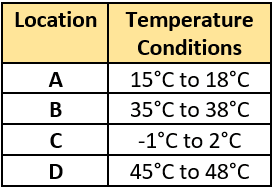
(a) location A
(b) location B
(c) location C
(d) location D
Ans.3. (c) paddy
Ans.4. (a) location A
Hint: Discover ways of breeding a better variety of seeds, in order to improve quality of crops.
Question.5. Crop Y is grown only in few areas due to specific temperature requirements. To increase the productivity of crop Y, it is recommended to develop its different varieties. Which feature should be included while developing the different varieties of crop Y in order to increase its productivity?
(a) Developing varieties with strong biotic resistance.
(b) Developing varieties with less dependence on water.
(c) Developing varieties with extended maturity duration.
(d) Developing varieties adaptable to different climatic conditions.
Question.6. Which of these would make a crop resistant to biotic stresses?
(a) Using insecticides to kill insects and other pests.
(b) Developing crop varieties that are tolerant to high soil salinity.
(c) Developing crop varieties that can grow in scarce water conditions.
(d) Growing crops in artificial set ups with fixed temperature and moisture content.
Ans.5. (d) Developing varieties adaptable to different climatic conditions.
Ans.6. (a) Using insecticides to kill insects and other pests.
Hint: Enlist various ways of enriching the soil in order to increase crop yield.
Question.7. What is the main input used in organic farming to enrich the soil?
(a) manure
(b) fertilizers
(c) herbicides
(d) pesticides
Question.8. A soil sample has adequate water holding capacity but is deficient in phosphorous and potassium. Which of these would improve the quality of crops grown in that field?
(a) Removing weeds
(b) Applying fertilizers
(c) Modifying irrigation system
(d) Growing two different crops at the same time
Ans.7. (a) manure
Ans.8. (b) Applying fertilizers
Hint: List down ways of irrigating a piece of land, in order to provide adequate water to all crops.
Question.9. Which of these the run-off from smaller catchment areas?
(a) tanks
(b) canals
(c) dug wells
(d) tube wells
Question.10. Town X is situated at the banks of a river. Due to inadequate release from the reservoir, often the agricultural farms of the town suffer from crop failures. Which type of irrigation would be suitable for town X?
(a) Building tanks
(b) Constructing canals
(c) Introducing river lift system
(d) Irrigating fields through dug wells
Ans.9. (a) tanks
Ans.10. (c) Introducing river lift system
Hint: Analyse ways/combinations of growing crops in order to maximize yield.
Question.11. Which statement correctly defines mixed cropping?
(a) growing two or more crops on the same field
(b) growing different varieties of same crop on the same field
(c) growing different crops on rotation basis on the same field
(d) growing two or more crops on the same field in a definite pattern
Question.12. A farmer in town X changed the cropping pattern of the farm. Earlier the farm had only soyabean but then the farm was divided into rows of different crops. Two rows of soyabean and alternate two rows had maize and the next two had cowpea. What would be the most likely effect of the new cropping pattern?
(a) Increase in yield
(b) Degradation of land
(c) Increased growth of weeds
(d) Reduced intake of nutrients by crops
Ans.11. (a) growing two or more crops on the same field
Ans.12. (a) Increase in yield
Hint: Describe ways/organisms by which crops get affected, in order to develop a solution to prevent them from attacking crops.
Question.13. Which of these adversely affects the health of the crops?
(a) weeds
(b) nutrients
(c) vitamins
(d) fungicides
Question.14. A crop X is to be grown in a field. It is seen that Parthenium, a type of weed usually affects crop X. What measure would help to protect crop X from Parthenium?
(a) Spraying pesticides
(b) Avoiding crop rotation
(c) Burning the field before sowing the crop
(d) Delaying the sowing of crops by a few days
Ans.13. (a) weeds
Ans.14. (a) Spraying pesticides
Hint: Develop better storage strategies for crops, in order to minimize storage losses.
Question.15. What should one select to store grains at home in order to prevent any spoilage?
(a) jute bags
(b) plastics bags
(c) earthen pots
(d) airtight glass jars
Question.16. Which strategy would help to minimize loss due to improper storage?
(a) adding manure to the produce
(b) drying the produce in sunlight before storage
(c) keeping the produce in open sacs to maintain airflow
(d) covering the produce with a wet cloth before putting on the lid of the container
Ans.15. (d) airtight glass jars
Ans.16. (b) drying the produce in sunlight before storage
Hint: List down some characteristics local and Foreign breeds of cattle, in order to develop a cattle with desired qualities
Question.17. If exotic breed of cattle have longer lactation period, which of these is a characteristic of Brown Swiss, a type of exotic breed?
(a) It will produce less milk.
(b) It will produce more milk.
(c) It will have a short life span.
(d) It will not catch diseases easily.
Question.18. The table lists the characteristics of few Milch breed of cattle.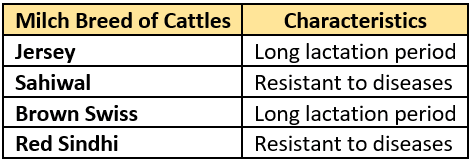
(a) The new breed will have a long lactation period and will be resistant to diseases.
(b) The new breed will have a small lactation period but will be resistant to diseases.
(c) The new breed will have a long lactation period but will not be resistant to diseases.
(d) The new breed will have a small lactation period and will not be resistant to
diseases.
Ans.17. (b) It will produce more milk.
Ans.18. (a) The new breed will have a long lactation period and will be resistant to diseases.
Hint: Outline food requirements and common diseases of cattle, in order to protect them better.
Question.19. Animal feed includes roughage and concentrates. What are the characteristics of concentrates?
(a) high in fiber
(b) very few nutrients
(c) high level of proteins
(d) less water content
Question.20. A cattle are affected by an external parasite. Which part of the cattle will most likely be affected?
(a) skin
(b) liver
(c) stomach
(d) intestine
Ans.19. (c) high level of proteins
Ans.20. (a) skin
Hint: Analyse desirable traits in poultry in order to maximize egg production and chicken meat.
Question.21. Which of these is to be considered before developing new varieties in poultry?
(a) Developing a breed with low maintenance
(b) Developing a breed with high maintenance
(c) Developing a breed that produces a smaller number of chicks
(d) Developing a breed with more food requirement
Question.22. What is the desirable trait in poultry for developing new varieties?
(a) tolerance to cooler temperatures
(b) decrease in the number of chicks
(c) Increase in the size of the egg-laying bird
(d) control the occurrence of diseases in chicks
Ans.21. (a) Developing a breed with low maintenance
Ans.22. (d) control the occurrence of diseases in chicks
Hint: Identify housing, nutritional & environmental requirements of poultry in order to prevent and control diseases.
Question.23. The table lists four types of food for broiler chickens.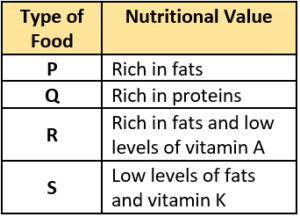
(a) food P
(b) food Q
(c) food R
(d) food S
Question.24. Virus, bacteria, fungi, and parasites affect the poultry fowl and often leads to the sudden deaths of poultry fowls. How can such loss of poultry be reduced?
(a) By providing low protein diet to poultry fowls
(b) By avoiding use of disinfectants on poultry fowls
(c) By reducing the intake of vitamins in poultry feeds
(d) By vaccinating the poultry fowls at regular intervals
Ans.23. (b) food Q
Ans.24. (d) By vaccinating the poultry fowls at regular intervals
Hint: Analyse the process of catching fish from seawater and fresh water, in order to maximize yield.
Question.25. Why Catlas, Rohus, Mrigals, and Grass Carps are kept in combination in a single fishpond?
(a) They have a short life span.
(b) They are resistant to diseases.
(c) They have less food requirement.
(d) They do not compete with each other for food.
Question.26. Four groups capture marine fishes with different instruments as listed in the table.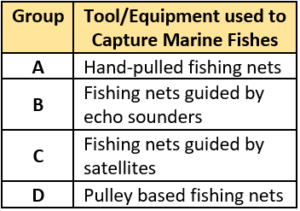
(a) groups A and B
(b) groups B and C
(c) groups C and D
(d) groups D and A
Ans.25. (d) They do not compete with each other for food.
Ans.26. (b) groups B and C
Hint: Name different varieties of bees and examine their traits, in order to maximize output.
Question.27. Which variety of bee is commonly used for producing honey commercially?
(a) A. florae
(b) A. dorsata
(c) A. mellifera
(d) Apis cerana indica
Question.28. The table describes the characteristics of Italian bees.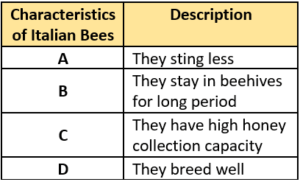
(a) characteristic A
(b) characteristic B
(c) characteristic C
(d) characteristic D
Ans.27. (c) A. mellifera
Ans.28. (c) characteristic C



